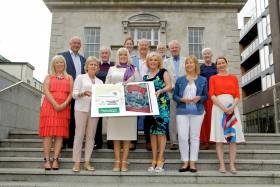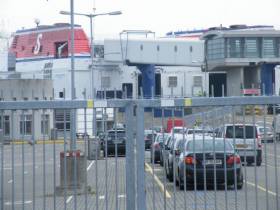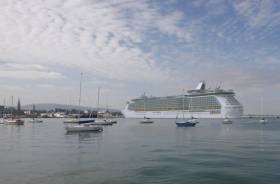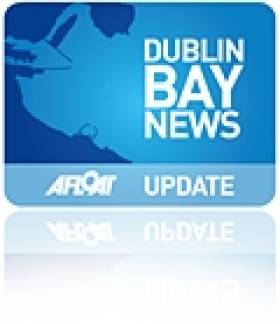Displaying items by tag: Dun Laoghaire News
Launch of Children's Book: You’d Be Filled with Wonder, The Story of Dun Laoghaire Harbour
#DunLaoghaireBook - “You’d Be filled With wonder, The Story of Dun Laoghaire Harbour! is the title of a new publication to celebrate last year's Bicentenary of Dun Laoghaire Harbour.
The harbour which began construction in 1817, has caught the imagination of writers, playwrights and poets for two centuries. Countless books have been written recalling the stories of shipwrecks, storms and forgotten heroes to all, but children.
The Blackrock Education Centre, supported by Dun Laoghaire Harbour Company, has created a children’s book as a legacy to the future custodians, sailors and visitors to the harbour.
To mark the enormous impact of Dun Laoghaire Harbour which has had on the local area the first children’s book about the harbour is now in bookshops . The unique book was written by local historian Dr Seamus Cannon with support from Grainne O Malley and Colin Scudds.
The book was designed by Eliane Pearce as a series of 15 bite sized stories highlighting key events in the harbour’s history. Tales of heroism, genius, celebration, tragedy and how the harbour began with a tragic double shipwreck and became the largest construction project of its time in Ireland.
Dún Laoghaire Harbour was witness to some of the great historical events of the past two centuries and these moments are captured in vivid colour with remarkable illustrations.
The book will ignite the imagination of school children along with curious adults and tourists alike. Available for €9.00 in local bookstores and alternatively to acquire online click here.
Coach Park In Dún Laoghaire Harbour Blocked
#DublinBay - A transport company based in the UK reports The Times, is involved in a planning row over the proposed use of the former ferry terminal in Dún Laoghaire Harbour as a coach park.
Go-Ahead, which recently secured contracts to operate public transport in Ireland, is appealing against a decision made by the local council, which refused the company the use of the former HSS Stena’s vehicle compound in Dún Laoghaire Harbour to park its buses.
The company fought off bids from Dublin Bus and Bus Éireann in tenders held by the National Transport Authority to secure routes around Dublin and Kildare. It now wants to use the disused ferry facility to park up to 20 buses overnight.
For more on the story click here and as Afloat previously reported the redevelopment plans of the former terminal building.
Special Relationships As Ships Meet in Dun Laoghaire Harbour
#SpecialRelationships - A pair of ships directly associated with Dun Laoghaire Harbour and that are both currently docked in the port is not often an occurance, writes Jehan Ashmore.
The presence of these ships within the harbour arms is noted, given the absence of other regular large harbour callers, notably the former Stena HSS fastferry. The high-speed service craft, HSS Stena Explorer had served to and from Holyhead until final sailings ceased in recent years.
Before the identity of these ships are revealed, firstly there is the clear distinction to be made between when the last HSS Stena Explorer sailing took place and the decision by Stena Line to finally announce in confirming that the service would be withdrawn.
The final sailings carried out by the HSS Stena Explorer actually took place in September 2014. As for the decision not to return serving the historic Irish-Welsh ferry route, this was officially announced the following year in early 2015.
Efforts have since ebbed and flowed to restore the service, however since 2011 the increase in cruiseship trade has taken over as the port’s ‘bread and butter’ income. In addition the Dun Loaghaire Harbour Company has striven in recent years to source new revenue streams that are not exclusively maritime led but driven from land-based ventures.
Among them the use of venue hire events, that this summer saw the return of the ‘Beatyard’ music festival that used the disused St. Michaels Ferry Terminal. The vehicle marshalling grounds instead were transformed to hosts acts featuring 1980’s pop hit band ‘Bananarama’.
All things maritime were not lost on organisers, Bech & Bodytonic as they called on festival-goers to have dress attire that was in the mode of ‘Nautical Boogie’… whatever that resulted in!
So what are these ships currently berthed in the Dun Laoghaire Harbour? They are the Commissioners of Irish Lights vessel, ILV Granuaile which arrived on Sunday. As for the second ship, that been the Naval Service flagship and helicopter patrol vessel, HPV L.E. LÉ Eithne that followed into port albeit arriving yesterday.
In fact both vessels were among a multi-agency flotilla (and airborne craft) gathering that Afloat had reported having completed successful marine Search and Rescue (SAR) demonstrations. They took place at the weekend off Dunmore East.
The SAR exercises held off the Waterford coast gave the public to witness the roles engaged by all concerned having been co-ordinated by the Irish Coastguard.
Earlier this year notably marked the 200th anniversary of the beginning to construct the then Kingstown Harbour, when officially Dun Laoghaire Harbour Bicentenary ceremony celebrations began at the end of May. Only a coastal excursion vessel, St Bridget operates out of the harbour for Dublin Bay Cruises that links between the capital and Howth Harbour on the far side of the peninsula.
At the time of writing, St. Bridget had carried out her routine Dublin Port-Dun Laoghaire cruise leg this morning and was alongside the harbour's famous East Pier, prior to heading for Howth. In addition to these seasonal services DBC run evening cruises from the south Dublin Bay harbour through Dalkey Sound and into the likewise scenic splendour of Killiney Bay.
With both naval and navigational related ships berthed in port, they also have a direct relationship with the harbour. ILV Granuaile’s homeport is Dun Laoghaire where the aids to navigation authority has its HQ located in addition to a marine engineering depot. On occasions the vessel moors alongside the HQ's near to Traders Wharf, however today the ship is berthed at Carlisle Pier having vacated a berth at St. Micheals Wharf where the LÉ Eithne has occupied.
The flagship has its adopted homeport of the harbour town where earlier this year Dun Laoghaire-Rathdown County Council awarded the ‘Freedom of Entry’ to the crew and the Irish Naval Service. This was to recognise the significant role played by Naval Service personnel in the task of humanitarian missions to rescue people in dire need from unseaworthy vessels and dangerous conditions in the Mediterranean Sea.
Cruise Berth at Dun Laoghaire Gets Go Ahead, But It's Not All Plain Sailing for Locals
#CruiseBerth - Mixed reaction from local businesses follows the decision to grant a new cruise ship berth with planning permission in Dun Laoghaire Harbour, writes the Herald.ie
The €18m development will allow ships of 250 metres in length to enter the port, paving the way for luxury cruise liners to dock at Dun Laoghaire. But locals are concerned that they will see little of the increased tourist trade promised by the development.
"It's going to put more nails in the coffin in Dun Laoghaire," said Andrew Ball, of Dunphy's Bar. "I personally don't think it's going to give us anything. People get on buses and go to the city - we don't see much of the benefit."
Neglected
Danielle Kelly, of Hicks butchers, said that anywhere away from the seafront has been "forgotten about".
"It was better when the boats from England were coming over on day trips. Most were originally from Dun Laoghaire or local and would stay here for the day," she said. "But now because they've stopped them they're all going out to town."
Declan Coates of Cameo Jewellers said that money might be better spent on developing the town. "It's lovely down on the seafront, but they've neglected up here on the streets," he said.
However, some locals were looking forward to added business from the cruise ships.
For more responses to the planning decision, the newspaper has more here.
Ferryport's Scrapyard! Transformed to Beatyard!
#Beatyard - The former Stena Line ferryport, Dun Laoghaire, notably this week has been a flurry of activity as St. Michaels Pier has been transformed in readiness for this weekend’s Beatyard, a multi-event attraction, writes Jehan Ashmore.
Heaps of scrap metal from the dismantled terminal was loaded onto trucks equipped with grabbers within the complex compound, where for almost two decades cars, coaches and trucks were marshalled before loading on board or driven off the HSS Stena Explorer. The craft ceased operating Dun Laoghaire-Holyhead crossings in September, 2014, as the operator consolidated services out of neighbouring Dublin Port, however, Dun Laoghaire Harbour Company are in the process of seeking to restore the Welsh route, but not until 2017 and using an adjoining berth.
In this compound area at St. Michaels Pier, event crews have assembled the Beatyard’s music performance stage, accompanied by marquees. Several shipping containers, used to advertise the event are next to the vehicle check-in booths The visitor attraction is not just about music, but offering a host of events.
The weekend’s Beatyard (July 30-31) is described as everything that’s good and great in the world of food, drink, tech, science, music, games, sports, arts, design and discussion.
Adjoining the Beatyard is the disused ferryport terminal building, which too was custom –built in the mid-1990’s for the introduction of the revolutionary Stena HSS, however retail/office space is currently available to let.
Ironically, the highspeed sea-service (HSS) Stena Explorer fastferry which could of gone likewise for scrap, like her North Channel counterpart, remains up for sale. The 1500 passenger/375 vehicle craft, when sold last year to Turkish interests, was to be converted in a floating office in Istanbul. In more recent months, this plan has been shelved.
The process of dismantling and removing Stena associated infrastructure is incomplete, as a remnant of the HSS linkspan-berth remains in situ, supported on a barge that was towed from Stranraer, Scotland. Leading off St. Michaels Pier is the jetty and supporting dolphins that too remain in the harbour, where the HSS Stena Explorer berthed using speciliast satellite technology that involved no mooring ropes but large clamps to wedge the craft into place.
In addition, a pair of concrete pillars remain, that once supported the glazed skywalk (east and west passenger gangways) connecting the HSS are also gone. What's left are these pillars than are visible, notably from the terminal entrance which is lined by the passenger check-in booths.
Above these booths are the terminal’s original marquee-like shade / shelter structures. They are seemingly more apt than ever as they compliment the Beatyard’s range of event marquees.
Stena Line Looking to Remove HSS Berth at Dun Laoghaire Pier
#HSSberthRemoval – Ferry operator, Stena Line announced that is it to apply for planning permission to remove its idle ferry berthing equipment at St Michael’s Pier in Dun Laoghaire Harbour over the coming months.
Back in April, Afloat reported on the future of the specialist berth-linkspan built only for the Stena HSS fast-ferry (which closed services to Holyhead almost a year ago) against the backdrop of the proposed €18m cruise-berth.
The ferry company took an advertisement out in the Dun Laoghaire Gazette which reports of this story which said Stena Line would be submitting a planning application to Dun Laoghaire-Rathdown County Council but, as yet, Dun Laoghaire-Rathdown County Council has not received a planning application for the works.
As part of Stena Line’s planning notice, it has stated that it will remove the east/west walkway, terminal walkways and the supporting steel and concrete structure at St Michael’s Pier.
By removing the berthing equipment at St Michael’s Pier, high-speed sea service (HSS) ferries will no longer be able to berth in the locality, but currently the Stena Line HSS is the only HSS vessel that docks in the berth.
For more on this story and responses from local councillors, click here.
Dun Laoghaire Town Vows to Survive Ferry Blow
#DunLaoghaireBID – The Dublin People writes that the Dún Laoghaire business community, will not be affected by Stena Line's recent decision to end seasonal ferry services from the town to Holyhead, a local group has insisted.
Despite widespread expressions of concern for the future of the town's economy following the announcement, the Dún Laoghaire Business Improvement District (BID) company said it expects no negative impact on the local business community.
The BID company said the Stena move will not affect retailers as Dún Laoghaire Harbour has been designated as a marine and leisure destination by the Dún Laoghaire Harbour Company Master plan and the National Ports Policy.
The BID focus on attracting leisure visitors, especially from the cruise industry, will be realised with over 100,000 cruise passengers set to arrive in Dún Laoghaire this summer, following an intense international marketing campaign by the Dún Laoghaire Cruise Stakeholders group, of which the BID Company is a member.
To read much more on this story, click HERE.
As previously reported on Afloat.ie, the Dun Laoghaire Harbour Company Ltd (DLHC) are seeking expressions from other providers to operate a seasonal ferry service on the Dun Laoghaire to Holyhead route.
For further details, click for advert HERE.
Afloat adds that according to the DLHC should a new operator be found such a service would not begin until 2016.
LexIcon Library: Soundings - Collective Memories of the Sea
#LexIconExhibition – Soundings: Collective Memories of the Sea is the inaugural exhibition programme currently held in the new Dun Laoghaire-Rathdown County Council Library headquarters – the dlr LexIcon.
Soundings which is exhibited in the Lexicon's Municipal Gallery, explores the relationships between Dún Laoghaire maritime environment of the sea and its people through artworks, talks and lectures.
Curated by Michael McLoughlin with thanks to Dún Laoghaire RNLI lifeboat crewmembers, Soundings brings together six artists with connections to Dún Laoghaire – the artists have investigated maritime histories, memories, testimonies and archives.
A range of free talks, workshops and performances take place as part of the exhibition.
Among the events is Sounds that Make the Harbour Visible: Wednesday 21 January: 1-2pm (Tea and Coffee provided)
A special screening of A Tribute to Sound, a short film by Simone Corr which commemorates the decommissioning of the foghorn from our coastline,will be followed by a talk. The bells, the foghorn and the maroons captured the imagination of the people of Dún Laoghaire and told a story of what was happening in the harbour.
Join Michael McLoughlin, Curator: Stephen Wynne,Dún Laoghaire RNLI; and Simon Coate, Dún Laoghaire Harbour Master as they discuss sounds of the harbour from the past and what happened as we moved into a more digital era.
RNLI Dun Laoghaire Exhibition
To explore and celebrate Dún Laoghaire's RNLI station, the crewmembers have created a video piece and a series of photographs, these can be viewed in the project room of dlr LexIcon.
For further information about the work of Dún Laoghaire RNLI please see their website: www.dunlaoghaire-lifeboat.ie
Booking: All workshops, talks and other events are free. Please book for all of the above unless otherwise stated as places are limited (to consult, please click HERE for Soundings exhibtion programme)
To book email [email protected] or phone (01) 271 9531 email [email protected]
The exhibition runs until Saturday 24 January 2015. For exhibition opening hours please go to: www.dlrcoco.ie/arts
No Wrecks Found in Search of Dun Laoghaire Harbour Form Part of Related Planning Process of Proposed New Cruise Berth
#WreckSurvey- Survey work for possible wrecks within Dun Laoghaire Harbour as previously reported, have the port company confirmed are related to the preparation of a planning application to An Bord Pleanala for a proposed new cruise pier berth, writes Jehan Ashmore.
In order to handle the 'next generation' of considerably larger capacity cruise ships with deeper drafts to dock inside the harbour at the proposed €15m cruise berth jetty would require dredging in the harbour channel. Any wrecks found that are deemed of archaeological significance must be made known before a dredging license can be granted.
It transpires no wrecks were found inside the harbour following searches by Geological Survey of Ireland (GSI) catamaran RV Keary which carried out an EIS on behalf of Dun Laoghaire Harbour Company. The works included some timbers located under a rock outside along the East Pier wall, though the timbers are long known about and were found by trainee divers many years ago.
Since the Dun Laoghaire Harbour reopened the cruise industry to the east-coast town in recent years after an absence of more than a decade, larger cruise ships still have to make anchorage calls offshore. Smaller cruise ships such as Serenissima berthed at Carlisle Pier which is opposite to the East Pier site of the 'Urban Beach Project' recently granted planning permission.
The proposed cruise berth jetty which would jut out from the Dun Laoghaire Marina's eastern breakwater and this would form an integral component of the harbour's 'masterplan' which is to develop new business in a port listed as one of five ports of regional significance.
Added to this is notably the future of the Stena Line service to Holyhead re-opening? in 2015 remains much in doubt. According to The Irish Times, should Stena Line pull operations from the port, sources estimated the move could cost the harbour company €7 million in lost revenue.
The harbour company plans to expand the cruise ship sector for 2015, in which next year's season as previously reported is to generate a record total of cruise passengers to the harbour and neighbouring Dublin Port.
GSI Investigates: Suspected Buried Timber Wreck Within Dun Laoghaire Harbour
#SuspectedWrecks – According to the Geological Survey of Ireland (GSI) they suspect a buried timber wreck lies close to the entrance of Dun Laoghaire Harbour, writes Jehan Ashmore.
In recent days the GSI's South African built research vessel RV Keary, named after Raymond Keary, one of Ireland's pioneering marine geologists, has been carrying out site investigations assisted by her tender boat.
The underwater work is also according to another source understood to be associated with the proposed cruise line pier. As part of these works divers over the next few days are to assess the archaeological significance (or otherwise) of up to two wrecks located within the harbour before a dredging licence can be granted.
On this occasion divers are to use an underwater vacuum system to suck the silt away from the wreck to discover what condition it's in.
One wreck is close to the East Pier Lighthouse and the other is in the centre of the shipping channel as shown in the photo above taken yesterday. The vessel is seen with a flag aloft her mast which denotes diving operations are underway.
The asymmetrical catamaran hull which is grey in colour having been constructed of marine grade aluminium, instead seemed to appear almost white due to the strong winter sunshine.
Designed by Nic De Waal of Teknicraft in New Zealand, RV Keary's specific design brief was to a nearshore, shallow water survey platform. The stout-looking craft was manufactured by Veecraft Marine of Capetown and completed in 2008.
She was transported by cargoship to northern Europe from where she continued her delivery voyage which took several days to include bunker calls en route along the UK south coast.
As she made passage along the Leinster seaboard she transited Dalkey Sound before finally reaching her homeport of Dun Laoghaire.
In recent years RV Keary has been joined by a smaller inshore RIB, RV Geo and the chartered Central Fisheries Board Cosantoir Bradan, a patrol squadron cutter.
RV Keary's fleetmates were also at the time in the harbour but berthed in the marina.































































